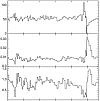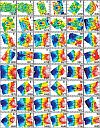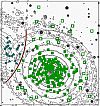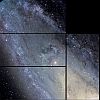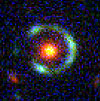The water ice rich surface of (145453) 2005 RR43: a case for a carbon-depleted population of TNOs?
Spectroscopic and spectrophotometric studies show that about 70% of Trans-Neptunian Objects (TNOs) present a mantle of complex organics on their surfaces. Long term processing by high energy particles and solar radiation on icy bodies, induces the formation of organic
species in their outer layers, resulting in a mantle that covers the unprocessed original ices. Until recently, the only case of a TNO with a surface covered basically by a thick layer of water ice was Charon, and it has been considered an intringuing case because of the need of
a resurfacing mechanism like cryovolcanism or collisons with micro-meteorites. Recently, it has been showed that other TNOs also have surface composition similar to Charon and are located in a narrow region of the orbital parameters space. The existence of a population
of TNOs with Charon-like surfaces and similiar orbital parameters needs to be explained as it can have a strong impact in the knowledge of the trans-neptunian belt formation theories and/or resurfacing mechanism. A study of the surface composition of the TNO (145453) 2005 RR43
using ISIS on the WHT showed that this object is indeed a member of such a population (Pinilla-Alonso et al., 2007, "The water ice rich surface of (145453) 2005 RR43: a case for a carbon-depleted population of TNOs?", A&A, 468,
L25).
DE CVn: a bright, eclipsing red dwarf-white dwarf binary
Large gaps remain in our knowledge of binary stellar evolution that affect our understanding of not only evolved compact binaries, but also of phenomena such as supernovae type Ia explosions, the rate of neutron star-neutron star mergers,
and the number of gravitational wave sources in our Galaxy. The poorly understood physics of the common-envelope (CE) phase results in considerable uncertainty in the binary evolution. During the
evolution of a binary, the more massive star turns into a giant. When the initial orbital period is small enough, the envelope of the giant will encompass the secondary star. The secondary and the
core of the giant will spiral in towards each other in a CE. When the envelope is expelled a close binary consisting of the core of the giant, which will evolve towards a white dwarf, and the unevolved
secondary star may emerge. The CE phase is expected to be very short, around less than 1000 years, and therefore is virtually impossible to observe directly.
To study the effects of this phase it is best to focus on
objects that have most probably undergone a CE phase in their past. These we identify with binary systems containing at least one stellar remnant where the current orbital separation is smaller than the radius of the giant progenitor, usually with orbital
periods shorter than 1 day. Close white dwarf-red dwarf binaries must have gone through a common-envelope phase during their evolution. DE CVn is a detached white dwarf-red dwarf binary with a relatively
short (~8.7 h) orbital period. its brightness and the presence of eclipses makes this system ideal for a more detailed study. From photometric and spectroscopic observations of DE CVn using ULTRACAM and ISIS on
the WHT among other instruments, a team of astronomers found that the mass of the white dwarf is 0.51 solar masses, its effective temperature is 8000 K, and it has a hydrogen-rich atmosphere (DA-type).
The red dwarf has a spectral type of M3V and its mass is 0.41 solar masses. They reconstructed its evolution and found that the progenitor of the white dwarf was a relatively low-mass star of less than 1.6 solar masses. The current age of this
system is 3.3-7.3×109 years, while it will take longer than the Hubble time for DE CVn to evolve into a semi-detached system (van den Besselaar et al., 2007, "DE Canum Venaticorum: a bright, eclipsing red dwarf-white dwarf binary",
A&A, 466, 1031).
Echoes from the companion star in Sco X-1
When the accreting compact object in an interacting binary is a neutron star or a black hole, the potential well is so deep that the infalling gas is heated to more than a million degrees Kelvin producing abundant
X-rays. These objects are therefore called X-ray binaries, and part of the observational work has concentrated on the so-called ultra-compact X-ray binaries (UCXBs). They are the X-ray binary cousins
of the AM CVn stars and are also promising sources of gravitational wave radiation.
Low-mass X-ray binaries (LMXBs) are interacting binaries containing a low-mass donor star transferring matter on to a neutron star or
black hole. Mass accretion takes place through an accretion disc, and with temperatures approaching ~108 K. In these binaries optical emission is dominated by reprocessing of the powerful X-ray luminosity in the gas
around the compact object which usually swamps the spectroscopic features of the weak companion stars. In this scenario, dynamical studies have classically been restricted to the analysis of X-ray transients during quiescence, where the
intrinsic luminosity of the donor dominates the light spectrum of the binary. Sco X-1 is the prototype LMXB and also the brightest persistent X-ray source in the sky and it has been the target of detailed studies since its discovery.
Simultaneous X-ray and ULTRACAM optical data of Sco X-1
were obtained to cover the full 18.9-h orbital period in 12 snapshots, yielding 16.1 ks of X-ray data and simulatenous optical photometry in three different bands. For the first time, astronomers were able to isolate
the emission line contributions from the mass donor star that respond to X-ray variations with a delay that is consistent with light traveltime between the X-ray source near the neutron star and the irradiated
face of the donor star that directly contributes to the emission (Muñoz-Darias et al., 2007, "Echoes from the companion star in Sco X-1", MNRAS, 379, 1637).
Searching for the lowest mass galaxies: an HI perspective
In the currently favoured cosmological models, structure evolves, by gravitational instability, from small, primordial, fluctuations in the dark-matter distribution. In this framework, galaxies form by cooling of gas captured inside the dark-matter haloes.
In normal-sized galaxies, this cool gas will form stars, making the galaxy visible in optical light. However, various physical processes may prevent the cooling of the gas, and therefore the formation of stars. Such haloes would
remain dark in optical light. One possibility is that small galaxies are not heavy enough to condense the gas to densities high enough for star formation to occur. It may also be the case that the radiation of the first large objects formed in the
universe keeps the gas in small galaxies ionised. Finally, it is conceivable that if a few stars form in a small galaxy, supernovae will expel the remaining gas, ahlting further star formation.
One possibility to test these various hypotheses is to study the neutral gas content of very small galaxies. The
various theories about what may happen to the gas when small galaxies form, make different predictions for the gas content. For example, if all the gas is expelled, there may be alower limit to the size of galaxies. On the other hand, if galaxies are too small to compress the gas so that stars can form,
one should find very small galaxies that are dark in the optical but are detectable in neutral hydrogen because they consist solely of gas. Such systems are dubbed "dark galaxies".
So far, blind extragalactic surveys of neutral hydrogen have failed to detect a population of dark galaxies. However, this may be due to these surveys not being sensitive to objects smaller than 107-8 solar masses of HI and hence they
may not be able to find the small, dark HI clouds predicted by some theories. To answer the question whether a significant population of gas-rich, low-luminosity, low-surface brightness
-or even dark galaxies- exists, it is necessary to reach lower HI massess.
In order to achieve this, a new blind HI survey using the WSRT telescope of 90 square degrees in the constellation of Canes Venatici (the so-called "CVn survey") was designed to be sensitive to objects with HI massess down to below 106 solar massess.
To be able to study the optical properties of the detections, the smaller galaxies were also observed with the INT WFC where images of the objects were made in different colours. These observations show that all objects detected in HI have clear counterparts in
the optical. Therefore, the data do not give any indication that, even when going to lower HI massess, dark HI objects exist (Kovac, 2007, "Searching for the lowest mass galaxies: an HI perspective", PhD thesis, Rijksuniversiteit
Groningen; Kovac et al, 2005, "The faint end of the HI mass function", IAU Colloquia, 198, 351).
The ING Overriding Programme and Gamma-Ray Bursts
The ING Overriding Programme continues to produce a significant number of papers, in particular in the field of Gamma-Ray Bursts. During 2006 and 2007, the following papers were published
using data from a wide variety of instruments (PFIP, LIRIS, ISIS, INGRID, AUX and WFC):
Castro-Tirado et al., 2006, “GRB 051028: an intrinsically faint gamma-ray burst at high redshift?", A&A, 459, 763;
De Ugarte Postigo et al., 2006, “GRB 060121: Implications of a Short-/Intermediate-Duration Gamma-Ray Burst at High Redshift", ApJ, 648, L83;
Fynbo et al., 2006, “Probing cosmic chemical evolution with gamma-ray bursts: GRB 060206 at z = 4.048", A&A, 451, L47;
Levan et al., 2006, “Infrared and Optical Observations of GRB 030115 and its Extremely Red Host Galaxy: Implications for Dark Bursts", ApJ, 647, 471;
Castro-Tirado et al., 2007, “The dark nature of GRB 051022 and its host galaxy", A&A, 475, 101;
Ruiz-Velasco et al., 2007, "Detection of GRB 060927 at z = 5.47: Implications for the Use of Gamma-Ray Bursts as Probes of the End of the Dark Ages", ApJ, 669, 1;
Curran et al., 2007, “GRB 060206 and the quandary of achromatic breaks in afterglow light curves", MNRAS, 381, L65).
New Milky Way Companions
The known satellite galaxies of the Milky Way all lie within ~300 kpc, and their brightest stars are resolvable from ground-based telescopes.
Thus, it is possible to acquire an enormous wealth of data on their stellar populations, making the satellite galaxies
important objects in many fields of astrophysics. They have also emerged as a battleground in near-field cosmology. Using data from the SDSS, astronomers have found 5 new satellites of the Milky Way, one of which was followed-up with the
Wide Field Camera on the INT. So far astronomers accept 14 mini-galaxies as Milky Way satellites (the dwarf irregulars Large and the Small Magellanic Clouds and 12 dwarf spheroidals), although sometimes the distinction
between star clusters and dwarf galaxies is somehow hazy. The possible disrupting satellites Canis Major and Virgo overdensities and the already absorbed dwarf known as the Monoceros Ring are other structures related to this research (V. Belokurov et al., 2007, "Cats and Dogs, Hair and a Hero: A Quintet of New Milky Way Companions", ApJ, 654, 897; F. Reddy, 2007, "SDSS finds new Milky Way satellites", May 2006 ).
The Angstrom Project Alert System
The Angstrom Project is undertaking an optical survey of stellar microlensing events across the bulge region of the Andromeda galaxy (M31) using a distributed network of 2 m class telescopes, among them, the INT and the Wide Field Camera.
The Angstrom Project Alert System (APAS) was developed to identify candidate microlensing and transient events in real time, using data from robotic telescopes. This is the first time that real-time
microlensing discovery has been attempted outside of the Milky Way and its satellite galaxies. The APAS is designed to enable follow-up studies of M31 microlensing systems, including searches
for gas giant planets in M31, and other transient events. In addition to the new observing data, the APAS uses archive data from the POINT-AGAPE dark matter microlensing survey of M31 (M. J. Darnley et al., 2007, "The Angstrom Project Alert System: Real-Time Detection of Extragalactic Microlensing", ApJ, 661, L45).











